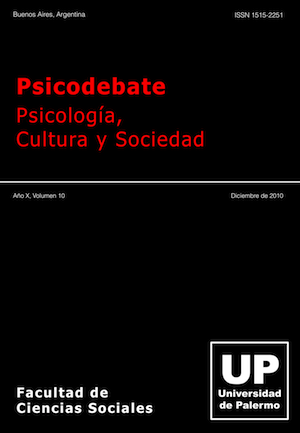Qué es una intervención positiva? Perspectivas Teóricas, Empiricas y Vivenciales
Resumen
El presente trabajo sigue tres hilos de investigación interconectados -teórico, empírico, y vivencial- para contestar una pregunta fundamental: ¿Qué es una intervención positiva? La primer parte, propone una definición teórica del término “intervención positiva”, y una hipótesis de cómo funcionan las intervenciones positivas. La segunda parte, presenta un sistema de clasificación basado en la investigación empírica, valor relevante para la longevidad de la Psicología Positiva como una disciplina académica. En la tercera parte, dos intervenciones positivas son exploradas vivencialmente, y relacionadas con el modelo teórico propuesto y la clasificación empírica de las intervenciones positivas. El entretejido de estos hilos provee una comprensión más profunda acerca de las intervenciones positivas, lo que permite su aplicación más efectiva y asegura la duración de la Psicología Positiva como un campo de esfuerzo científico previniendo su declinación en una moda pasajera de auto-ayuda.
Descargas
Citas
Bandura, A. (1994). Self-efficacy. In V. S. Ramachaudran (Ed.), Encyclopedia of human behavior (Vol. 4, pp. 71-81). New York: Academic Press. Available on-line at: http://www.des.emory.edu/mfp/BanEncy.html.
Baumeister, R. F., Gailliot, M., DeWall, C. N., Oaten, M. (2006) Self-Regulation and Personality: How Interventions Increase Regulatory Success, and How Depletion Moderates the Effects of Traits on Behavior. Journal of Personality. 74, 1773-1802.
Carnegie, D. (1936/1981). 2. A simple way to make a good first impression. In How to win friends and influence people. Rev. Ed. New York: Pocket Books.
Compton, W. C. (2005). Positive psychology interventions. In An introduction to positive psychology (pp. 182-195). Belmont, CA: Wadsworth.
Csikszentmihalyi, M. (1990). Chapter 2: The anatomy of consciousness. In Flow: The Psychology of Optimal Experience (pp. 23-42). New York: HarperPerennial.
Fordyce, M. W. (1977). Development of a program to increase personal happiness. Journal of Counseling Psychology, 24, 511-521.
Fordyce, M. W. (1983). A program to increase happiness: Further studies. Journal of Counseling Psychology, 30, 483-498.
Hill, N. (1937/1983). Chapter 1: Thoughts are things. In Think and grow rich. New York: Fawcett Crest.
James, W. (1892). Habit. In Principles of Psychology: Briefer Course. James, W. (1892). Will. In Principles of Psychology: Briefer Course.
James, W. (1897). The gospel of relaxation [just the first short section]. In Talks to Teachers.
King, L. A. (2001). The health benefits of Writing about Life Goals. In Personality and Social Psychology Bulletin, 27, 798-807.
Latham, G. (2000). Motivate employee performance through goal-setting. In Locke E. A. (Ed.), Handbook of principles of organizational behavior (pp. 107-119). Oxford: Blackwell.
Lopez, S. J., Snyder, C. R., Magyar-Moe, J. L., Edwards, L., Pedrotti, J. T. Janowski, K., Turner, J. L., & Pressgrove, C. (2004). Strategies for accentuating hope. In Linley, P. A. & Joseph, S. (Eds.), Positive psychology in practice (pp. 388-404). Hoboken,NJ:Wiley.
Melchert, N. (2002). Aristotle: The reality of the world. The Good Life. In The Great Conversation: A Historical Introduction to Philosophy, 4th ed., Boston: McGraw-Hill.
Mutrie, N. & Faulkner, G. (2004). Physical activity: Positive psychology in motion. In Linley, P. A. & Joseph, S. (Eds.), Positive psychology in practice (pp. 146- 164). Hoboken, NJ: Wiley.
Pawelski, J. O. (2003). Is healthy-mindedness healthy? Cross Currents, 52, 404- 412.
Pawelski, J. O. (2004). Character as ethical democracy: Definitions and measures. Journal of College and Character, http://www.collegevalues.org/pdfs/ James%20Pawelski.pdf.
Pawelski, J. O. (2005). Mitigative Meliorism. University of Pennsylvania, unpublished manuscript.
Pawelski, J. O. (2006). Teaching Pragmatism Practically: A Promising Approach to the Cultivation of Character. Contemporary Pragmatism. 3, 127-143.
Peale, N. V. (1952/1982). Preface, Introduction, and Chapters 1-3. In The Power of Positive Thinking. New York: Fawcett Crest
Robbins, A. (1991). Chapter 6—How to change anything in your life: The science of Neuro-Associative ConditioningTM. In Awaken the Giant Within (pp. 123-149). New York: Simon & Schuster.
Rowling, J. K. (1999). The Boggart in the wardrobe. In Harry Potter and the Prisoner of Azkaban (pp. 123-139 hardcover, pp. 94-106 paperback). London: Bloomsbury.
Ryan, R. M., & Deci, E. L. (2000). Self-determination theory and the facilitation of intrinsic motivation, social development, and well-being. American Psychologist, 68-78.
Ryff, C. D., & Singer, B. (2002). From social structure to biology: Integrative science in pursuit of human health and well-being. In Snyder, C. R., & Lopez, S. J. (Eds.), Handbook of positive psychology (pp. 541-555). New York: Oxford University Press.
Salovey, P, Caruso, D., & Mayer, J. D. (2004). Emotional intelligence in practice. In Linley, P. A. & Joseph, S. (Eds.), Positive psychology in practice (pp. 447-463). Hoboken, NJ: Wiley.
Shapiro, S. L., Schwartz, G. E. R., & Santerre, C. (2002). Meditation and positive psychology. In Snyder, C. R., & Lopez, S. J. (Eds.), Handbook of positive psychology (pp. 632-645). New York: Oxford University Press.
Smith, W. P., Compton, W. C., & West, W. B. (1995). Meditation as an adjunct to a happiness enhancement program. Journal of Clinical Psychology, 51, 269- 273.
Los autores/as que publiquen en esta revista ceden los derechos de autor y de publicación a Psicodebate y aceptan el registro de su trabajo bajo una licencia de atribución de Creative Commons, que permite a terceros utilizar lo publicado siempre que de el crédito pertinente a los autores y a Psicodebate

















